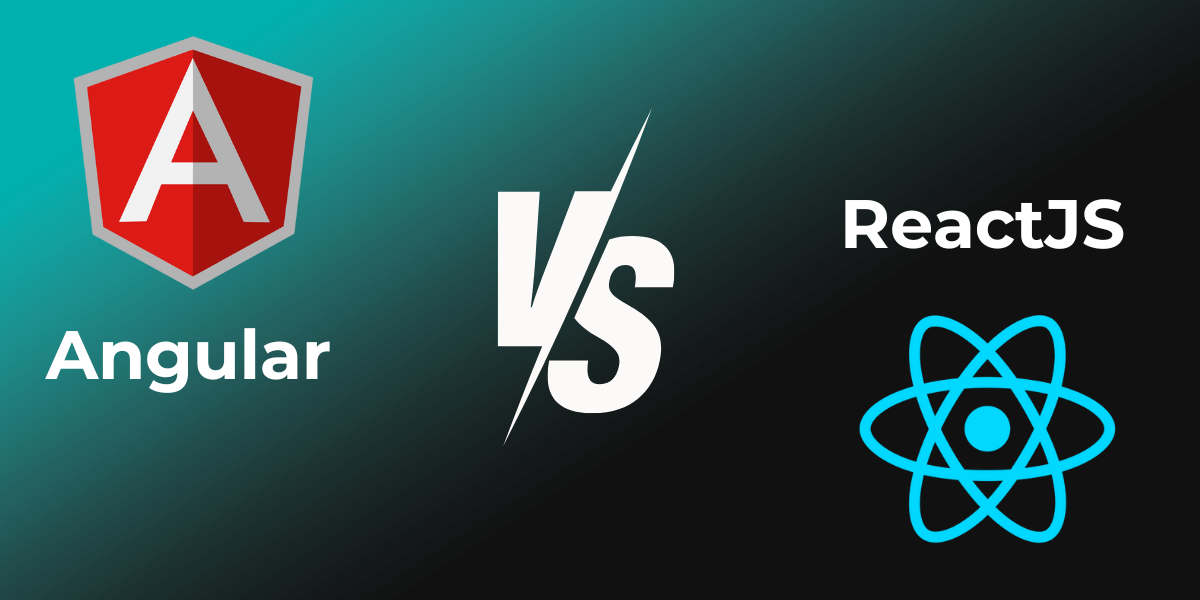Home > Angular vs React JS: Which is the Best Framework in 2024?
Are you hesitating between Angular and React JS for your next web project in 2024? This comprehensive guide offers a detailed analysis of these two essential frameworks: Angular vs React JS. Angular, backed by Google, and React, developed by Facebook, are among the most popular technologies for modern application development today. We explore their strengths, key differences, and the advantages of each according to your project’s specific needs. Whether you’re seeking the power of Angular for large-scale projects or the flexibility of React for dynamic interfaces, this article will help you make the optimal choice.

Angular and React JS, backed respectively by Google and Facebook, enjoy strong credibility among businesses. This technological support is a key factor in their growing popularity in the web development world.
According to Google Trends, React has dominated searches over the past five years, indicating its growing interest among developers. In 2023, according to Statista, React was used by 40.58% of developers, compared to 17.46% for Angular. This trend continues into 2024, with React being the most sought-after JavaScript technology.
Nevertheless, Angular remains a popular choice for dynamic web application development, thanks to its flexibility and versatility. Both frameworks maintain their popularity, each offering distinct advantages and features.

Angular is an open-source framework based on TypeScript, developed by Google in 2016. It is designed to create single-page applications (SPA) for the web and mobile using TypeScript and HTML. Its modular architecture allows clear code organization, making maintenance and structure easier. Angular vs other frameworks shows its advantages.
With Angular, developers benefit from many built-in features, such as dependency injection, simplifying the management and testing of components. Additionally, Angular’s Ahead-Of-Time (AOT) compiler converts TypeScript and HTML code into JavaScript during build time, optimizing performance.
Angular stands out for its all-in-one approach, where developers have access to a complete ecosystem for developing, testing, and debugging applications, making it a robust choice for large-scale projects.
React JS, developed by Facebook in 2013, is a JavaScript library used to build dynamic user interfaces. It is particularly appreciated for its ability to create performant and responsive interfaces, ideal for web and mobile development.
One of React’s key features is its use of the virtual DOM, which allows quick updates without reloading the page. This approach greatly improves application performance by reducing the time required to reflect changes in the user interface.
The flexibility of React allows developers to combine this library with other tools and frameworks, offering great freedom in development. The latest version of React, released in 2024, continues to enhance its features, strengthening its position as a preferred choice for developers.

Angular vs React JS show significant differences in their architecture and operation. Angular is a full framework based on TypeScript, offering an all-in-one solution for application development. In contrast, React is a JavaScript library focused on building user interfaces, often requiring integration with other tools for full functionality.
Angular uses two-way data binding, simplifying synchronization between the model and view, while React uses one-way data binding, giving developers more control. Additionally, Angular manipulates the real DOM, whereas React uses a virtual DOM, improving performance.
These differences make Angular more suitable for large-scale projects requiring a rigorous structure, while React is ideal for interactive and dynamic applications requiring high performance and quick loading.
Summary of advantages: Angular Vs React JS
| Criteria | Advantages of Angular | Advantages of React JS |
|---|---|---|
| Support and Longevity | Backed by Google, ensuring continuous evolution and long-term support. | Backed by Facebook, ensuring wide adoption and ongoing development. |
| Framework Type | A complete framework offering an all-in-one solution for development, testing, and debugging. | A JavaScript library specialized in creating dynamic and interactive user interfaces. |
| Learning Curve | Steeper learning curve due to its complexity and use of TypeScript. | Easier and quicker to learn, especially for those with JavaScript knowledge. |
| Performance | Optimized for large applications thanks to differential loading management and modular structure. | Optimizes performance with its virtual DOM, ideal for applications requiring frequent updates. |
| Data Binding | Two-way data binding facilitates synchronization between the model and view. | One-way data binding allows better control over data flows and effective state management. |
| Integrated Ecosystem | Provides an integrated ecosystem with tools like RxJS and Angular CLI, facilitating state management, routing, and testing. | Offers flexibility in integrating with other tools and frameworks, thanks to the reusability of components. |
| Modularity | Highly modular, suitable for large-scale projects requiring a robust architecture. | Highly flexible, perfect for projects where a lightweight and adaptable approach is desired. |
| Performance Optimization | Ahead-Of-Time (AOT) compiler improves performance by converting code at build time. | Virtual DOM allows fast updates and minimizes operations on the real DOM, optimizing application responsiveness. |
| Community and Support | Active and vast community with solid support from Google and comprehensive documentation. | Growing community, with numerous resources available, facilitating problem-solving and ongoing development. |
Angular benefits from long-term support from Google, ensuring its longevity and continuous evolution. Its integrated ecosystem enables smooth collaboration with other libraries and frameworks, optimizing developer productivity.
Angular’s two-way data binding facilitates synchronization between the model and view, making development more intuitive. Additionally, its MVC architecture and optimizations like differential loading allow for the creation of fast and efficient applications, ideal for large-scale projects.

React’s virtual DOM improves efficiency by updating only the necessary parts of the user interface, which optimizes performance. This approach is particularly beneficial for applications that require frequent updates.
React also stands out for the flexibility and reusability of its components, making development and maintenance easier. Applications developed with React are easy to test, and React’s simplicity, integrating HTML and JavaScript via JSX, makes it an accessible choice for many developers. Comparing React vs other libraries highlights its advantages.
Angular excels in developing large-scale applications thanks to its well-defined structure and robust features. It is particularly suited for projects requiring complex state management.
Angular’s modular architecture and built-in tools for state management, routing, and forms make it a top choice for enterprise-level applications. This modular structure also facilitates the maintenance and evolution of applications, beneficial for long-term projects.
React JS is preferred for applications requiring frequent updates, such as Progressive Web Apps (PWA). It is also commonly used to create responsive and adaptive web applications, particularly web applications.
React’s integration with GraphQL has become a standard for simplifying data management between the frontend and backend. Additionally, React is often favored for smaller projects where a flexible approach is needed.

The learning curve for Angular is considered steep, requiring a good understanding of TypeScript and its complex architecture. Beginners often find this complexity daunting, demanding considerable effort to get accustomed to it.
In contrast, the learning curve of React is regarded as simpler and faster to grasp. React is designed to be accessible, with a less complex structure, allowing developers to start projects more quickly.
To effectively learn React, intermediate experience with JavaScript is crucial, as this makes it easier to understand the core concepts. Efficient updates in React, related to its virtual DOM management, also make development easier for newcomers.
In performance tests, React showed an average performance of 88,433 ms, highlighting its efficiency. This performance is largely due to rendering speed and the efficient management of the virtual DOM, which improves application responsiveness.
Angular, on the other hand, optimizes page loading through the ‘tree-shaking’ technique, eliminating unused code to improve performance. A comparison of Angular and React performance shows that each has its own advantages depending on the specific needs of the project.
Key tools for development with Angular include:
Angular offers an integrated solution for testing and debugging, while React requires several additional tools for these tasks.
On the other hand, React’s library encourages component reusability, which can receive input data, offering great flexibility in creating dynamic user interfaces. The complete and accessible documentation for both frameworks guides developers throughout the development process.

React enjoys significant support from Facebook, while Angular is supported by Google. Both frameworks have vast developer communities, facilitating knowledge sharing and resource availability.
Active support forums and regular events around Angular and React encourage community engagement and continuous skill development. The documentation and resources available for both technologies are significant assets for developers.
The choice between Angular and React primarily depends on the specific needs of the project and the development team’s requirements. The structure and complexity of the project are crucial factors in choosing which framework to use.
It is also essential to consider the experience of the developers in the team and their personal preferences. Ultimately, considering the team’s skills and long-term goals is crucial to making an informed choice.

Angular vs React JS, each offers distinct advantages depending on the needs and goals of your project. Angular, with its integrated ecosystem and rigorous structure, is ideal for large applications requiring complex state management. React, on the other hand, stands out for its flexibility, optimized performance, and ease of learning, making it a preferred choice for interactive and dynamic applications.
Whatever your choice, it is essential to carefully evaluate your project’s specific requirements and your team’s skills to ensure successful development. In 2024, both frameworks continue to dominate the web development landscape, each bringing robust and innovative solutions.
The main difference between Angular and React lies in the fact that Angular is a complete framework using TypeScript, while React is a JavaScript library primarily focused on building dynamic user interfaces.
React is generally considered easier to learn than Angular due to its smoother learning curve and simplicity. This makes it a preferred option for those new to web development.
Angular is best suited for large-scale projects where rigorous structure and complex state management are essential. This makes it a preferred choice for robust and maintainable applications.
Choosing React for web application development is wise because it allows for the creation of interactive applications with frequent updates while optimizing performance thanks to its virtual DOM. This efficiency makes it an excellent choice for modern projects.
The community and support advantages for Angular and React lie in their strong backing from Google and Facebook, respectively, as well as access to a large developer community and numerous resources. This makes problem-solving and continuous learning easier for developers.

ITTA is the leader in IT training and project management solutions and services in French-speaking Switzerland.
Our latest posts
Subscribe to the newsletter
Consult our confirmed trainings and sessions

Nous utilisons des cookies afin de vous garantir une expérience de navigation fluide, agréable et entièrement sécurisée sur notre site. Ces cookies nous permettent d’analyser et d’améliorer nos services en continu, afin de mieux répondre à vos attentes.
Monday to Friday
8:30 AM to 6:00 PM
Tel. 058 307 73 00
ITTA
Route des jeunes 35
1227 Carouge, Suisse
Monday to Friday, from 8:30 am to 06:00 pm.